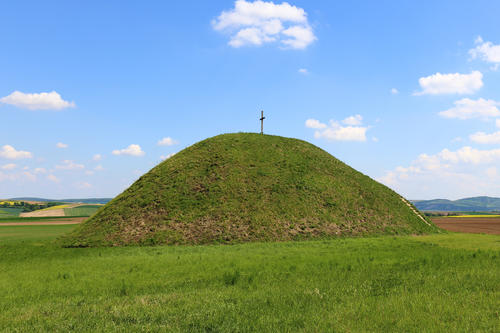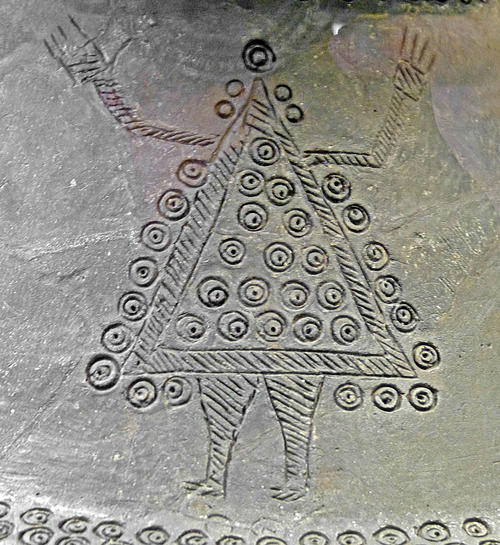Great Women Make History
Prehistorians discover that the massive burial mounds of the early Celts were used for more than just men.
Jun 28, 2016
A grave mound in Großmugl, Austria
Image Credit: © Bwag Wikimedia
Representation of a dancer in rich costume on a vessel from the cemetery at Sopron-Burgstall in Hungary. The vessel is currently in the Natural History Museum in Vienna.
Image Credit: Wolfgang Sauber/Wikicommons, CC by-sa
The people of the early Iron Age – which in Central Europe falls between about 800 and 450 B.C. – buried their dead in large burial mounds. These tombs often contain valuable grave goods made from gold and other exotic materials, pointing to the power of those buried there. Researchers have called them the tombs of “Celtic princes,” but more detailed studies have led to a startling discovery. Many women, too, were buried in richly appointed surroundings.
The tiny village of Vix in northern Burgundy (population 100) was home to a treasure that lay unknown for more than two millennia: a vessel made of bronze, the height of a grown person, weighing 208 kilograms with its richly decorated handles and able to hold a volume of 1,100 liters. The krater, as these kinds of vessels are known among archaeologists, was one of many valuable items buried in a mound dating to the fifth century B.C., which was discovered in 1953, about 2,500 years after the burial.
Person Buried in Grave Wore a Torque of Pure Gold
Scholars place the sumptuous Vix Grave within what is known as the western Hallstatt culture. People in this area were known to writers in antiquity as Celts. The person buried in the grave wore a torque of pure gold and other necklaces. Statuettes and amphorae from Italy and Greece attest to the far-flung trade relations that must already have existed among these people at the time.
Who might this person have been? Right from the start, there were various signs that the person entombed there might be a woman. But until the 1980s, researchers believed the person was a male priest, possibly a transvestite. Today, there is a definite answer: The person buried in the mound was a woman. Not much is known about her, but she must have been a high-ranking member of early Celtic society.
The “Priestess of Vix,” as she is also known, contradicts assumptions that had been made in previous research. Scholars had previously espoused the “big man” theory originating in cultural anthropology, which holds that it was generally charismatic men who fought their way to positions of leadership in early Celtic society. But were there also “big women”? This is the subject of inquiry for Christin Keller and Katja Winger at the Institute of Prehistoric Archaeology at Freie Universität.
The two scholars are studying the Hallstatt culture, which during the Iron Age extended from what is now northern France through Germany and into eastern Austria and the northern Balkans. Keller has studied a large number of grave finds and gathered information on the sex and social status of those buried there.
“I have analyzed all of the significant data sets using statistical methods, and what I found was that even in the eastern Hallstatt area, where there has been little research to date, there are very richly appointed women’s graves,” she says. And that leads Keller to a new conclusion: “The old model of the prince who held the power needs to be reconsidered.” Based on this finding, the two archaeologists recently held a conference that brought scholars and researchers from all over Europe to Freie Universität.
Rethinking Gender Roles in Antiquity
Over 16 talks, they presented their research on gender roles in antiquity. The focus was on the early Celts in the area of the Hallstatt culture and more. For example, one scholar of religion from Freie Universität Berlin analyzed the female characters in Homer’s Odyssey, while a classical archaeologist from Goethe University Frankfurt gave a talk on whether the Greek myth of the Amazons might have been rooted in reality.
The proceedings of the conference will be published in the coming year. They will lay out one clear conclusion: The women of the Iron Age must have played a greater role in society than was previously thought. “The models used in the social sciences and cultural studies need to be developed further in order to depict gender roles in all their facets,” Keller explains.
She adds that it is equally important to use more scientific methods in studying graves in the future. For example, excavation methodology has made great strides in recent decades, Keller says, but modern paleogenetics also holds out the prospect of a wealth of new insights. This field analyzes a fraction of the genetic material found in ancient remains: mitochondrial DNA, which can be used to trace relationships through the maternal line. Keller explains that this unlocks valuable insights into the structure of prehistoric societies.
Further Information
- Dr. Christin Keller, Institute of Prehistoric Archaeology, Freie Universität, Tel.: +49 30 838 54254
- Dr. Katja Winger, Institute of Prehistoric Archaeology, Freie Universität, Tel.: +49 30 838 72690, Email: Katja.Winger@fu-berlin.de


